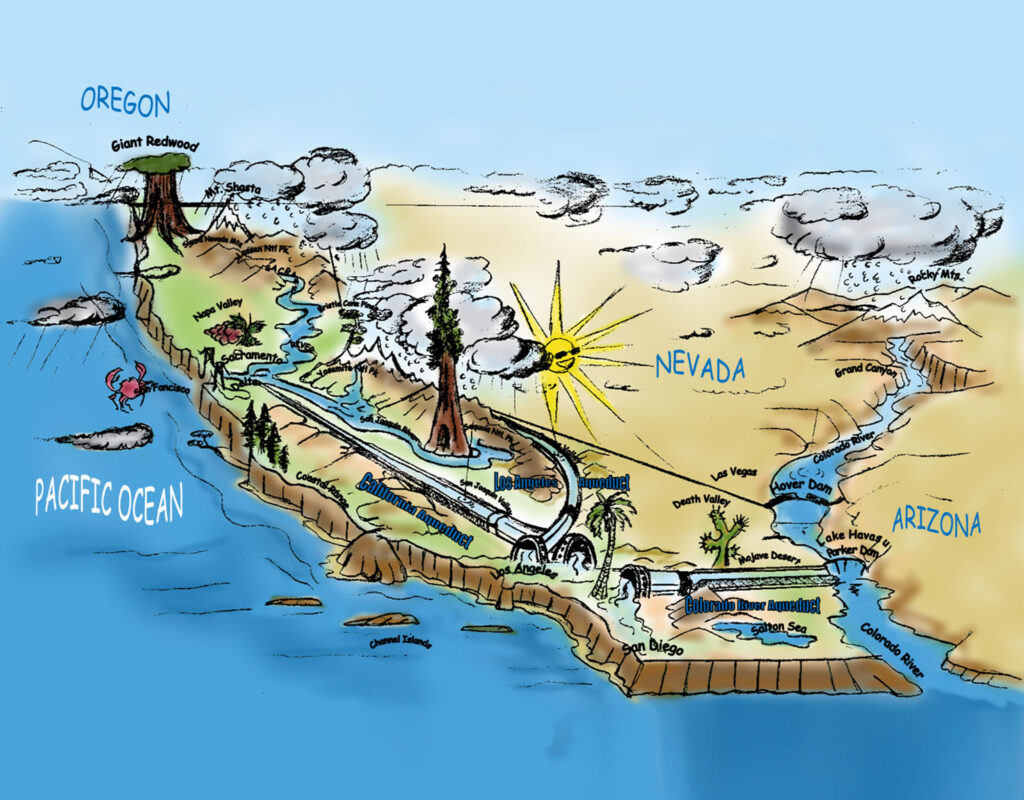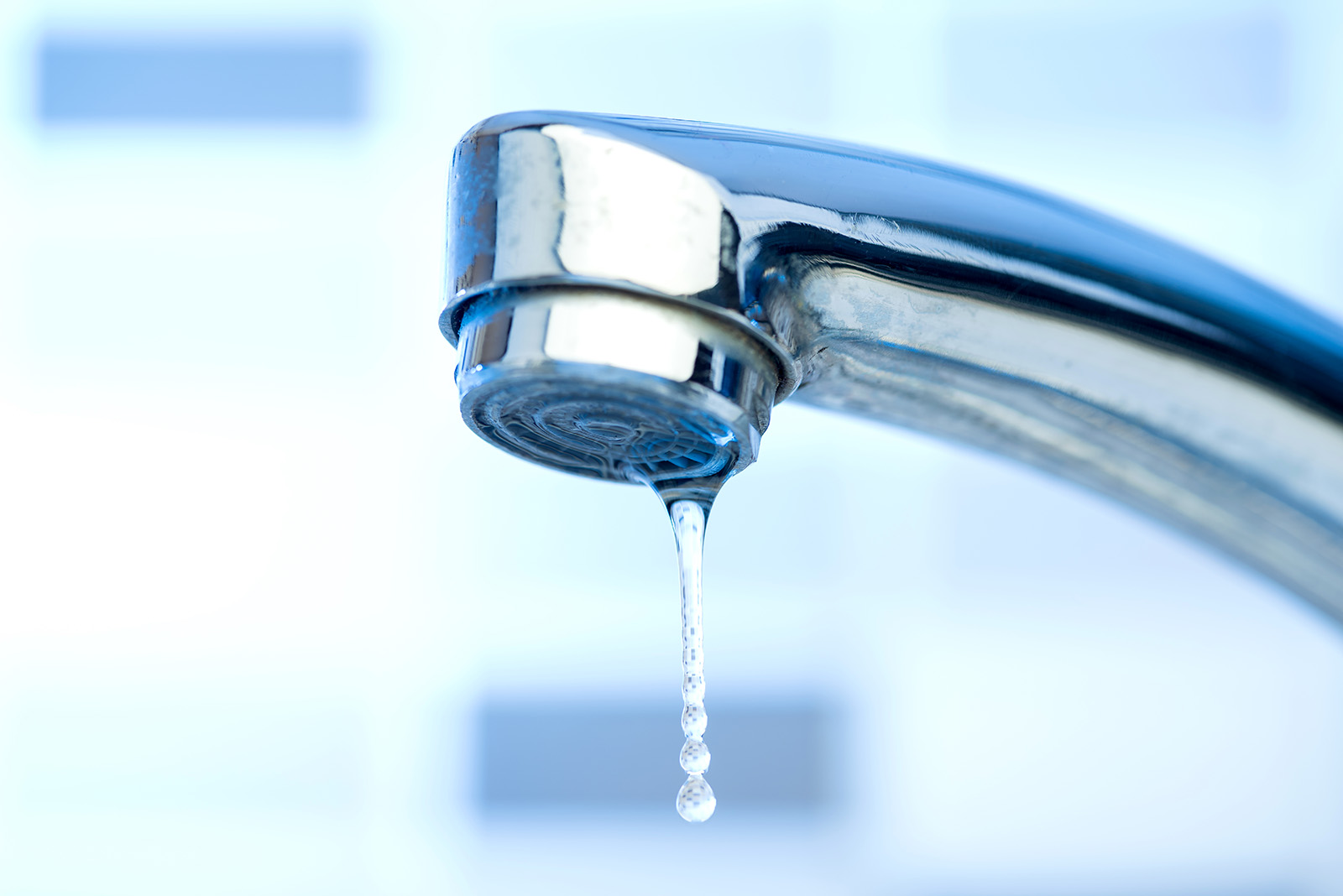LEARN ABOUT
Water Supply
The water supply of Los Angeles County is a diverse mix of groundwater, surface water, imported water, and recycled water.

Local Water
Local water supplies consist primarily of groundwater aquifers within Los Angeles County and local surface water due to rainfall in the mountain and valley watersheds.
Groundwater
Groundwater represents a significant portion of local supplies in the County. Most groundwater basins in the County are adjudicated (via a court decision) and producers within these basins follow management guidelines established by their respective adjudications. Groundwater basin recharge can occur via existing and restored natural channel bottoms or percolation of rainwater (natural recharge), however natural recharge is typically insufficient to maintain basin water levels and current pumping levels due to the extent of impervious surfaces and the presence of clay soils in parts of the County. Many agencies rely on artificial recharge, by diverting local supplies from rivers or creeks when flow conditions are optimal, to spreading grounds (or basins) which typically contain sandy soils that promote infiltration.
Local Surface Water
Los Angeles River
The Los Angeles River flows 51 miles from the union of Bell Creek and Arroyo Calabasas in the San Fernando Valley, then southeast through the City of Burbank and eventually southward to Long Beach. Originally, the Los Angeles River was the primary water source for the City of Los Angeles. Today, the river is primarily fed from stormwater, effluent from wastewater treatment plants, urban runoff, base flow from the Santa Monica and San Gabriel Mountains, and groundwater inflow in the Glendale Narrows.
Water agencies that have water diversion rights within the Los Angeles River watershed include the City of Pasadena and the City of Los Angeles. The City of Pasadena has rights to up to 25 cubic feet per second (cfs) of Arroyo Seco runoff, though the yield of the Arroyo Seco is highly variable depending on weather and rain patterns, and uses its diversions for both direct use and groundwater recharge. Pasadena both uses its rights for recharge of the local groundwater basin and treats it for direct use. The City of Los Angeles has full rights to flows in the Los Angeles River and uses its diversion rights for groundwater recharge at various locations in the San Fernando Valley.
San Gabriel River
The San Gabriel River flows 75 miles southwest from the San Gabriel Mountains, then southward from the Whittier Narrows to its ocean discharge at the City of Seal Beach. Unlike the Los Angeles River, due to more favorable soil conditions, the San Gabriel River has a natural bed for most of its length, although the banks are armored with rip rap and concrete for flood control purposes. The river is fed by stormwater, base flow from the San Gabriel Mountains, dry weather urban runoff, and effluent from wastewater treatment plants. Significant quantities of surface water naturally recharge groundwater via the permeable bottom of the San Gabriel River and are also used for groundwater recharge in several locations. During the dry season, the presence of dams and other diversions can result in river flow that is sometimes discontinuous, as some river reaches are dry, while other reaches have flow. Conversely, the regulated flows released from the dams in some cases could also extend the periods of river flow.
Imported Water
Imported water consists primarily of water obtained from the State Water Project, LA Aqueduct, and Colorado River. Water retailers purchase imported water from local contractors or regional wholesale water agencies.
State Water Project
The State Water Project (SWP) includes 22 dams and reservoirs, a Delta pumping plant, and a 444-mile-long aqueduct that carries water from the Delta through the San Joaquin Valley to Southern California. The SWP begins at Oroville Dam on the Feather River and ends at Lake Perris near Riverside. At the Tehachapi Mountains, giant pumps lift the water from the California Aqueduct 2,000 feet over the mountains and into southern California.
The SWP provides irrigation water to farms in the San Joaquin Valley and is a major source of supply for cities in Los Angeles, Riverside, San Bernardino, San Diego, and other parts of southern California. The project is operated by the California Department of Water Resources.
Colorado River
The 1,440-mile-long Colorado River passes through parts of seven states, several Indian reservations, and the Republic of Mexico. California is entitled to 4.4 million acre-feet of water annually from the river. Most of that water irrigates crops in the Palo Verde, Imperial, and Coachella valleys, located in the southeastern corner of the state, but Colorado also is a vital source of water for urban Southern California. Urban supplies are distributed by the Metropolitan Water District (MWD) of Southern California through its Colorado River Aqueduct. MWD is a water wholesale agency that supplies water to water districts that serve 18 million customers in Los Angeles, Orange, San Diego, Riverside, San Bernardino, and Ventura counties.
Los Angeles Aqueduct
Aqueducts built by the City of Los Angeles draw water from the Owens River, Mono Lake Basin, and reservoirs on the east slopes of the southern Sierra. In Los Angeles, a 223-mile aqueduct completed in 1913 has served as a major water supply source, conveying water from the Owens River in the eastern Sierra. A second aqueduct, completed in 1970, added another 50 percent capacity to the water system. The two aqueducts deliver an average of 430 million gallons a day to the city.
Recycled Water
Recycled water is wastewater that is purified through multiple levels of treatment. This processed water is treated to strict standards set by the California Department of Health Services and is rigorously monitored by local, state, and federal agencies to ensure it continuously meets those standards. Recycled water is safe for irrigation, industrial, and agricultural uses.
More recently, advanced treatment techniques have been utilized to produce highly purified (near distilled quality) recycled water for a wider range of purposes including indirect potable reuse, in which highly purified recycled water is used to recharge underground aquifers.
The use of recycled water helps to conserve drinking water and promote sustainability by reducing the need to import water over long distances or pump our limited groundwater supplies.
Where does recycled water come from?
Recycled water comes from the treatment of wastewater. Wastewater is produced when we use sinks, showers, toilets, appliances, and machinery in our homes and businesses. Wastewater is piped through sanitary sewers to wastewater treatment plants where it progresses through stages of treatment of disinfection.
In Los Angeles County, the County Sanitation Districts of Los Angeles County own and operate the largest wastewater recycling program.
The recycled water produced by wastewater treatment plants is sold through local public and private water suppliers. A network of purple pipes and pumps delivers the recycled water to the recycled water users
